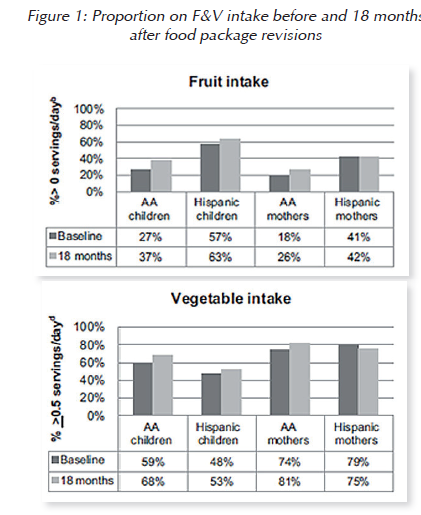The 18-Month Impact of WIC Food Package Revisions on African-American and Hispanic Families
2005 Dietary Guidelines for Americans1. These revisions provided more whole grains, fruits, and vegetables, and fewer foods with high saturated fat content. These were the first food package changes in the WIC program since its inception approximately 40 years ago2-4.
This study examined the 18-month impact of the 2009 WIC food package revisions on nutrient and food group intake and overall diet quality among African American and Hispanic WIC child participants and their mothers/caregivers. This analytic sample included 209 mothers (Hispanic, n=112; African American, n=97) and 164 children aged 2-4 years (Hispanic, n=94; African American, n=70). Dietary intake was assessed with 24-hour dietary recalls collected immediately before WIC food package revisions occurred in Chicago and 18 months following the food package change.
Improvement in intakes of total fat, saturated fat, fiber and overall dietary quality among Hispanic Children The most prominent changes occurred among Hispanic children who decreased total fat and saturated fat intake and improved intake of dietary fiber and overall diet quality. No notable changes were observed in these categories for African American mothers and children or Hispanic mothers.
Since these improvements were not also observed among African American children, acculturation and ethnic identity may have been contributors to why Hispanic children saw greater improvements. For instance, Kranz et al. found ethnic identity (i.e. Mexican descent) to be a positive predictor of diet quality among low-income preschoolers5. Previous studies also support the notion that less acculturated Hispanics consume more healthful diets6. The level of acculturation in the sample could be characterized as ‘low’ as measured by acculturation score and language use.
Focus on F&V consumption
Improvements in fruit and vegetable consumption were minimal across all groups (figure 1). This result may be explained by the monthly voucher amount ($6 per child). This relatively small voucher amount may have been insuffi cient to produce a notable increase in intake for any individual family member. Findings from Herman and colleagues7 provides evidence that a larger voucher amount may be needed to infl uence fruit and vegetable consumption.

Limits and recommendations
This study should be viewed in light of limitations. First, the sample is not representative of all Hispanic and African American children in WIC. Due to resource limitations, only one 24-hour recall was collected, which does not fully characterize usual dietary intake.
To tackle a pervasive problem such as obesity, wide-reaching policy changes, such as the 2009 WIC food package revisions, are necessary. Providing reciprocal reinforcement to support behavior change can make it easier for families with young children to make healthier choices, and ultimately have an impact on obesity.
Based on: Angela Kong, Odoms-Young AM, Schiffer LA, Kim Y, Berbaum ML, Porter SJ, Blumstein LB, Bess SL, Fitzgibbon ML. Am J Prev Med, “The 18-Month Impact of Special Supplemental Nutrition Program for Women, Infants, and Children Food Package Revisions on Diets of Recipient Families”
References
- US Department of Health and Human Services & US Department of Agriculture. Dietary Guidelines for Americans 2005. 2005; 6th [Available from: http://www.health.gov/dietaryguidelines/dga2005/document/
- Institute of Medicine. WIC food packages: Time for a change. Washington DC: National Academies Press, 2005.
- United States Department of Agriculture Food and Nutrition Service. Special Supplemental Nutrition program for Women, Infants, and Children (WIC): revisions in the WIC food packages; delay of implementation date. Federal Register 2008: 72(52):14153.
- United States Department of Agriculture Food and Nutrition Service. Special Supplemental Nutrition Program for Women, Infants, and Children(WIC): revisions in the WIC food packages; interim rule. Federal Register; 2008; 72 (234): 68965.
- Kranz S, Findeis JL, Shrestha SS. Use of the Revised Children’s Diet Quality Index to assess preschooler’s diet quality, its sociodemographic predictors, and its association with body weight status. J Pediatr (Rio J) 2008;84(1):26-34.
- Ayala G, Baquero B, Klinger S. A Systematic Review of the Relationship between Acculturation and Diet among Latinos in the United States: Implications for Future Research. Journal of the American Dietetic Association 2008;108(8):1330-44.
- Herman DR, Harrison GG, Afi fi AA, Jenks E. Effect of a Targeted Subsidy on Intake of Fruits and Vegetables Among Low-Income Women in the Special Supplemental Nutrition Program for Women, Infants, and Children. Am J Public Health 2008;98(1):98-105.
